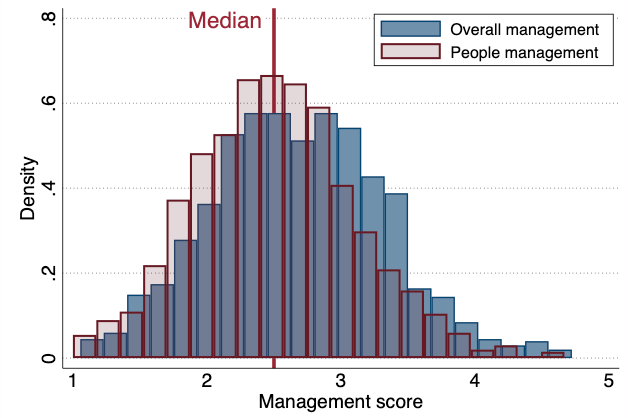
Total Factor Productivity (TFP) is a measure used by economists and business people to quantify the productivity of economies and firms. It essentially measures how efficiently and intensively the inputs to production (like capital and labour) are used. TFP receives a lot of attention and is often the main point of motivation behind research projects. Technology affects how these inputs are assembled, and we can look at technology either as tangible (new and better machines), or intangible (such as managerial practices and production processes).
One important way that intangible technologies affect firm performance is by improving managers’ ability to build the most productive and appropriate workforce they can. We know that more structured management practices lead to higher productivity, and we also know hiring higher quality workers is correlated with higher productivity.
But, specifically, how is this all happening? What levers are firms pulling to get this optimal mix of workers in their firm?
Labour market models show that while different firms try to optimally attract workers with different levels of ability, these models often do not take into account specialised investments in managerial processes or managerial talent. The models abstract away from real-world differences in the personnel management practices of different firms, but we do not yet know how much those differences matter, and why. In our new research paper, we dig deeper into that black box and show how firms with structured management are better at hiring, firing, and retaining workers.
Drilling down to these practices is a very data intensive exercise. To document these intricate relationships we need a dataset that includes all the job spells of paid employees in an economy, including their wages and occupation, and also a lot of information at the firm level, including industry, productivity, and use of different management practices. It is exceedingly hard to find this data except in a select few countries in the world where this unique combination of data is available to some degree (such as here and here). We created the most comprehensive dataset of this kind to date, using three different data sources from Brazil: The employer-employee matched dataset covering the entire formal sector for ten years (RAIS), the annual industrial survey (PIA) for productivity data, and the World Management Survey (WMS) for management practices data.
The Brazilian dataset uniquely allowed us to observe the occupation of workers, as well as the reason for separation. Since most other employer-employee datasets show workers moving across jobs, without knowing the reason for separation, we would not be able to identify whether the worker quit on their own, or whether they were fired. Furthermore, without detailed occupation codes, we would not be able to cleanly separate managers from production workers, which we find quite important in understanding the compositional relationship. As our dataset has these important variables, we can take a new look into what is going on in these firms.
We start by defining firms that have structured management practices as those scoring over a score of 3 in the WMS scoring grid of 1 to 5. Methodologically, that is the cut-off point in the survey: firms that have some management practices in place, but where these practices are informal and only adhered to sometimes (usually requiring the manager to be present), cannot reach a score of 3. For a 3 to be awarded, the processes described must be formalised, though they are allowed to have some weaknesses.
We find that there is plenty of variation among firms in the Brazilian sample of the WMS, as can be seen in Figure 1. Half of the firms score above a 2.66, with the other half scoring below that score. While we can replicate the results using a continuous definition of management, the WMS definitions offer a cleaner way to distinguish and interpret our results.
Figure 1. Distribution of management scores

Note: Data from the WMS Brazil only. 2008 and 2013.
We then use a well-known methodology to extract two “fixed effects” from the data on employee flows and wages: The Abowd, Kramarz and Margolis (AKM) decomposition. Essentially, this decomposition uses the transitions of workers between jobs within and across firms to allows us to estimate (i) how much more a worker gets paid moving from firm A to firm B (the “firm-fixed effect”), and (ii) what the value of a particular worker’s portable skills are across jobs. Portable skills refer to the traits and skills of workers that have some value in the labour market, and they carry those along with them as they move through firms (the “person-fixed effect”). We extract these two fixed effects for all firms and workers in the Brazilian sample, we then rank all production workers and managers separately by their fixed effect and see where they work; in structured management firms, or unstructured management firms.
We can summarise our main results in three main figures.
1. Firms with structured management practices do a better job at hiring the “best” people — that is, people with the highest “person-fixed effects” from the AKM model. The median manager hired in a firm with structured management practices comes from above the median ranking in the full distribution (58th percentile), while the median manager hired in a firm with unstructured management practices comes from below the median ranking in the full distribution (46th percentile). Figure 2 summarises this relationship. If all firms hired at random, both curves would be along the 45-degree line. The bulging to the right means structured firms have positive recruitment (that is, they are hiring from higher ends of the distribution), while the bulging to the left means unstructured firms have negative recruitment (they are hiring from the lower ends of the distribution.
Figure 2. Structured management firms are better at hiring workers
Managers

Production workers
 2. Once the firms with structured management hire the best workers, they are also better able to keep them over time. In Figure 3 we highlight the share of workers from the top and bottom of the rank distribution that work in structured and unstructured firms over our ten years of data. It is striking that, consistently, firms with structured management practices retain a much larger share of workers in the top quantile of the worker quality distribution.
2. Once the firms with structured management hire the best workers, they are also better able to keep them over time. In Figure 3 we highlight the share of workers from the top and bottom of the rank distribution that work in structured and unstructured firms over our ten years of data. It is striking that, consistently, firms with structured management practices retain a much larger share of workers in the top quantile of the worker quality distribution.
Figure 3. Structured management firms are better at retaining top workers
Managers

Production workers

3. We look at how firms let go of workers. In Figure 4, we see two very clear patterns in the data: Structured management firms have lower levels of firing. One likely reason is, as we have seen, is that better hiring organisations, tend to have better job matches in first place and thus, generally needing to fire fewer workers. Another clear pattern is that when they do fire, they are more selective: that is, firms are more likely to dismiss workers with lower person-fixed effects relative to unstructured firms. This suggests that they are better able to identify the worse workers. In short, we have found evidence that firms with more structured practices hire better, retain better, and fire less (and more selectively). But what types of business practices are more strongly correlated with having employees of higher quality?
4. People management practices are correlated with better production workers at the firm, but both operations and people management practices are correlated with better managers at the firm. This was surprising to us, but it is quite intuitive. To explore this we separately looked at the relationship between higher levels of structured management in people management practices and in operations management practices.
Figure 4. Structured management firms fire less often, and more selectively

One potential explanation that fits these results is that the people management practices are primarily geared at production workers, so it makes sense that these practices would be more strongly correlated with workers in that occupation. Operations management, on the other hand, could make firms more attractive to better managers or the better managers could be implementing a large set of better operations and people management practices. It is hard to know which way the causality runs, but this is the first time that we see these types of patterns so clearly in the data.
In all, it is now an accepted stylised fact that more structured managerial practices have a strong effect on firm productivity, though we are still unpacking the black box of why that relationship exists. We see this set of stylised facts as the first step in an exciting research agenda exploring the labour aspect of this relationship. A whole new set of questions arise based on these patterns, such as whether structured management helps firms mitigate unhelpful managerial biases, whether they are more able to optimise their internal labour markets, or whether these firms can improve the human capital of their workers.
♣♣♣
Notes:
- This blog post is based on the author’s paper Building a Productive Workforce: The Role of Structured Management Practices, with Christopher Cornwell and Ian Schmutte, LSE’s Centre for Economic Performance (CEP) Discussion Paper 1644, August 2019.
- The post gives the views of its author, not the position of LSE Business Review or the London School of Economics.
- Featured image by geralt, under a Pixabay licence
- Before commenting, please read our Comment Policy
 Daniela Scur is an assistant professor of strategy at the Dyson School of Applied Economics and Management at Cornell University. She has a PhD in economics from the University of Oxford (Nuffield College) and is a research associate at LSE’s Centre for Economic Performance and a research affiliate at CEPR. She studies how managers make management decisions, and in turn how this affects productivity and labour markets across a range of industries.
Daniela Scur is an assistant professor of strategy at the Dyson School of Applied Economics and Management at Cornell University. She has a PhD in economics from the University of Oxford (Nuffield College) and is a research associate at LSE’s Centre for Economic Performance and a research affiliate at CEPR. She studies how managers make management decisions, and in turn how this affects productivity and labour markets across a range of industries.






Interesting findings! However, since the analysis is based on brazilian datasets, I wonder to what extent this is related to the current level of economic development in Brazil? Would the patterns shift as the economy progresses to higher levels when innovation and creativity, as opposed to efficient production, becomes more improtant for productivity and value creation? Would the patterns identified from this study apply to more developed economies?